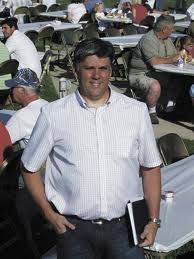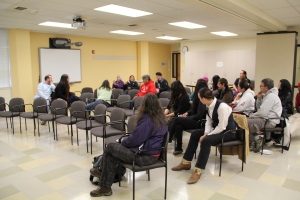
(click to see story)
There is a new fight that is brewing against the Bureau of Land Management (BLM) and the residents of Utah, namely in the small town of Blanding. While it might be understandable the frustration they are feeling because of the ineptitude of the BLM and its disorganized and seemingly arbitrary delineations of land demarcations, they do still have a job and they need to be accountable for doing it. Thus, the backlash against the federal government is beginning to culminate in the local White Mormon residents of Utah vs. the BLM, especially in the wake of the FBI raids of 2009 when they claimed that the alleged law-breakers were arrested with excessive force using “overkill” force by the feds.

Billboard upon entering Blanding, Utah: both Indians and artifacts
As stated by MotherJones.com: “This Saturday, angry residents of San Juan County, Utah, plan to illegally ride their ATVs through Utah’s Recapture Canyon—an 11 mile-long stretch of federal land that is home to Native American archeological sites—because they don’t think that the federal Bureau of Land Management should have designated that land off-limits to motor vehicles. The protest was meant to be a local affair. But on Thursday, Bundy, the rancher who wouldn’t pay the feds grazing fees and sparked a gun-drenched showdown in Nevada, called on his supporters to join the anti-government off-roading event, E&E Publishing’s Phil Taylor reported. Bundy, whose crusade against the federal government became tainted by his racist comments, is looking to spread the cause from cattle to cross-country cruising.”

All Terrain Vehicles (ATV’s) can do damage on trails with fragile ecosystems and irreplaceable archaeological sites of indigenous ancestors which are all over San Juan County
This time, the BLM is the target for this same demographic and is supported by the son of Cliven Bundy of Nevada who is recently become somewhat popular among staunch Republicans as a poster boy for American land-owners against the BLM but is also…a recorded racist in talking about African-Americans. Apparently, these same people have forgotten that it is not a question about them owning the land or the government land because it is not their land: it is Native American land.

Cliven Bundy of Nevada
Let me restate that so it sinks in: If this is a question about being an American with freedoms and rights to own land without as much government interference or regulation, then you couldn’t be more spot on when talking about Native American communities, everywhere, including there in Utah, who have had to deal with not just the government but the settler-colonial agents of Westward Expansion and Manifest Destiny since the beginning of this Western imposed nation-state you call America. This argument does not include Indians because we are older than America and preclude these “rights” that were written for a similar crowd at the time of the Constitution (white land owners who were business man and developers). Whose land is this? This is Indian land. It has always been our land. It will always be our land. We are not going anywhere. We will not leave. This is our home. The sooner both ranchers like Bundy or San Juan citizens like Phil Lyman can get that, the more they can get to the root of the problem: Land issues.

Phil Lyman, San Juan County Commissioner leading ATV protest
Could it be that they are so desperate to talk about land issues that they are willing to use racists and their sons as symbols of their fight? Or is that just a natural inclination of San Juan citizens according to the treatment of American Indians in the local area in a number of cases (i.e. disrespectfully selling and collecting Native American artifacts in 2009, attempting to defy the Antiquities Act and Eastern Lands Bill for land use open to everyone by Congressman Bishop in 2013, etc.) Even Bundy’s argument misses the mark because there were the Dann Sisters, of the Western Shoshone tribe, who tried to fight for their land and their ranch but were not as publicly recognized or given as much attention about their land issues as Bundy seems to be getting now. Maybe its because the sisters didn’t say anything racist. I don’t know.

Western Shoshone Dann sisters of Nevada
Utah officials and citizens are hiding behind their “rights” as American citizens that they pretend to respect but are willing to literally tread upon their own government for their own benefits. In addition, they disrespect the local Native American populations as well by not listening, respecting, or leaving the artifacts that are not supposed to be collected alone. They are willing to destroy ancient archaeological artifacts and sites that are supposed to be protected, preserved, and acknowledged as spaces that should be respected. In this day and age, with both Native and non-Native peoples sharing a community and land, there is no excuse for this kind of ignorance mixed with privilege and power from a powerful group “asserting” its “rights” over another marginalized group. It is appalling to me the conduct of a supposedly Mormon town towards their own nation and other sovereign indigenous nations that live there in the area such as the White Mesa Paiute, Ute Mountain Tribe, and the Navajo. Do these Blanding citizens have no other way to show their protest than to destroy the place that they love by riding ATV’s over it and not including Native American perspectives in this conversation?

Ancient indigenous archaeological sites of San Juan County

















 www.
www.